Post by Romy Ocon on Dec 14, 2007 7:23:43 GMT
These two Canon medium range telephotos have been my favorite light birding lenses. Which between the two is the better birding or wildlife lens is the subject of long (and sometimes heated) discussions in various internet forums.
Canon 400 5.6L (rightmost) and Canon 100-400 L IS (second from the right), in the company of their bigger brothers (Sigmonster and 500 f4 L IS)
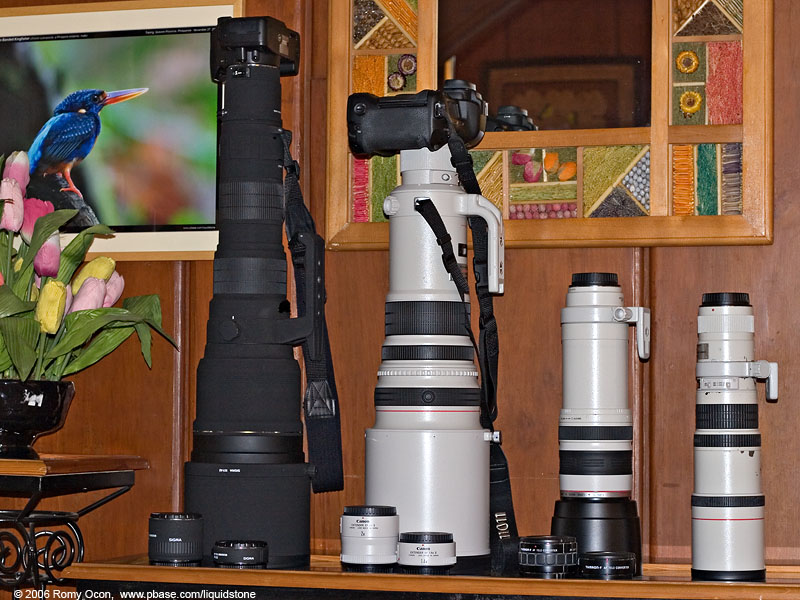
The 400 5.6L is cheaper, lighter, faster focusing and has a sturdier lens hood. But it has no IS, minimum focus distance is a far 11.5 feet, and being a prime, one has to zoom with the feet.
The 100-400 L IS has stabilization, framing flexibility and closer minimum focus distance (6 feet). But it has a flimsy hood design, not quite as long as the prime at 400 mm, a bit slower AF, higher price, and many of the earlier copies are not so sharp at full zoom wide open.
SUBIC BAY (January 2005): I was shooting a Philippine Woodpecker at Triboa Bay Mangrove Park with the hand held 300D + 100-400 L IS + DG Super + Better Beamer, while my 20D + 400 5.6L hangs ready in case some flying raptors come into view.
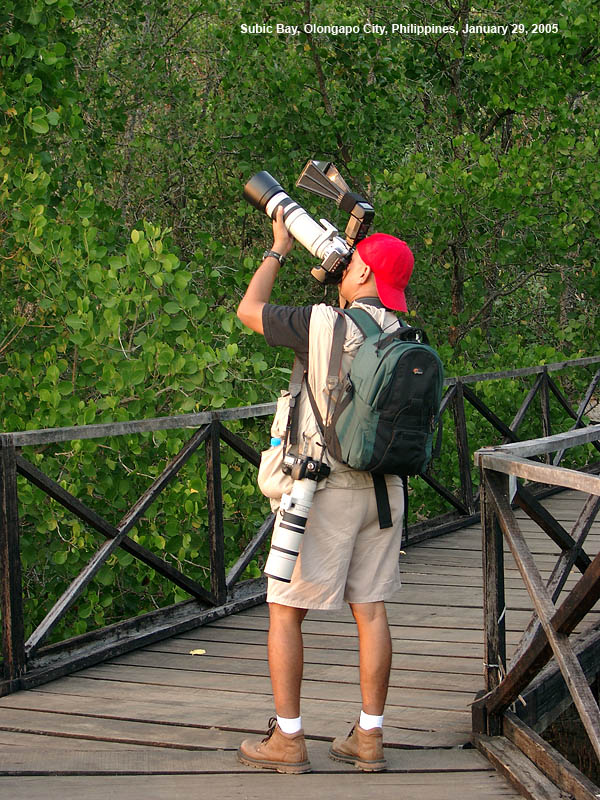
My first 100-400 L IS (mfd year 2002) was soft at 400 mm wide open, and became decent only when stopped down to about f/7.1-f/8. Then I stumbled upon an excellent copy of the zoom (mfd year 2005) over a year ago. I promptly sold my first copy. This second copy of the zoom matches the sharpness of my 400 5.6L at full zoom wide open (see following lens test).
Shoot-out: Canon 100-400 L IS vs Canon 400 5.6L (dial-up warning - 1.1 MB file)
www.pbase.com/liquidstone/image/86416630/original
The 400 5.6L, with its light weight and faster AF, is a flight specialist - Whiskered Tern, 1DM2 + 400 5.6L, 1/1600 sec, f/8, ISO 250, hand held:

On the other hand, the 100-400 with its IS is easier to hand hold - 1DM2 + 100-400 IS + Sigma 1.4x TC, 560 mm, f/8 (wide open), 1/320 sec, ISO 400, hand held:

So, going back to the question of which lens I recommend after taking thousands of bird photos with both..... I'd lean towards the 100-400 L IS but on the condition that it has to be tested first before one commits buying to make sure it's a good copy.
If one can get a zoom copy which is as sharp as the prime at 400 mm wide open, like I did, the choice is quite very easy. Since getting my prime-sharp 100-400, my 400 5.6L was relegated to back-up duty and has rarely left my camera bag, even at BIFs - Whiskered Tern, 40D + 100-400 IS, 400 mm, f/5.6, 1/1600 sec, ISO 400, hand held:

And a major crop of a dark flier in fading sunlight - Barn Swallow, 1DM2 + 100-400 L IS, 400 mm, f/5.6, ISO 500, 1/800 sec, hand held:

A Little Egret in flight over Candaba wetlands - 1DM2 + 100-400 L IS, 400 mm, f/7.1, ISO 400, 1/1600 sec, hand held:

A quick test of the bokeh of each lens:


A Purple Swamphen (Porphyrio porphyrio) captured at Candaba wetlands with the hand held 1DM2 + 100-400 IS, 400 mm, f/5.6, ISO 320, 1/400 sec, manual exposure, resized full frame:

Processed 100% crop of the above photo:
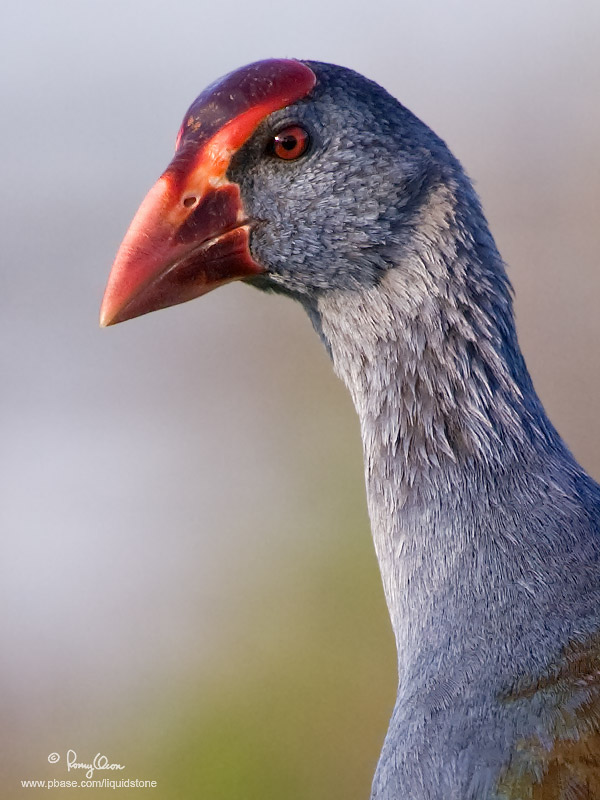
Another processed 100% crop, same settings as the above photo (Note - I've printed the full frame of this photo to 20"x30" for a museum exhibit and it's still so sharp that I believe it can still be upressed to 24"x36" easily):

Trying the 100-400 IS at the moon with a 2x TC:


Getting greedy with a 2.8x TC on the 100-400 IS!


And getting most greedy with a 4x TC!

With its framing flexibility, the 100-400 works decently at landscapes too, and IS helps a lot in hand holding.
1DM2 + 100-400, 120 mm, f/10, ISO 250, 1/200 sec, manual exposure, hand held from a moving ship, 98.6% of full frame (due to horizon correction), resized to 1200x800:

100% crop from the center:
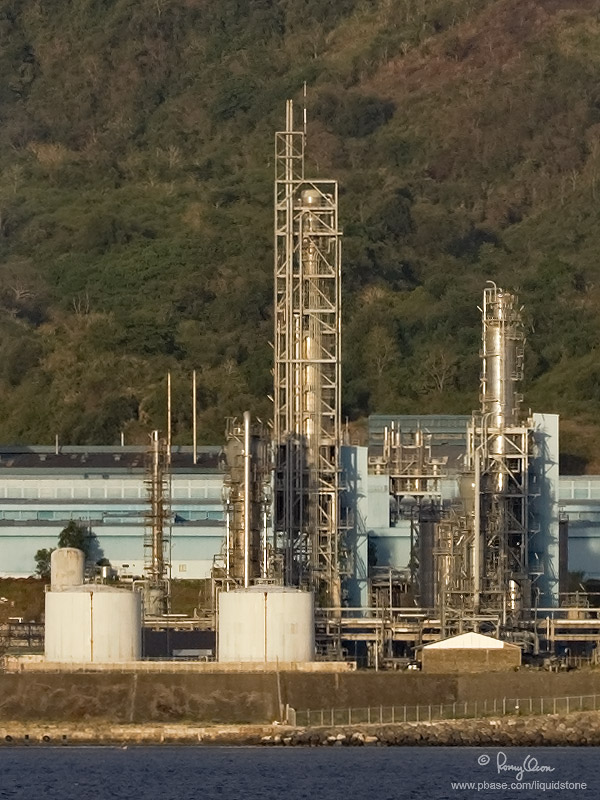
100% crop from the right edge:
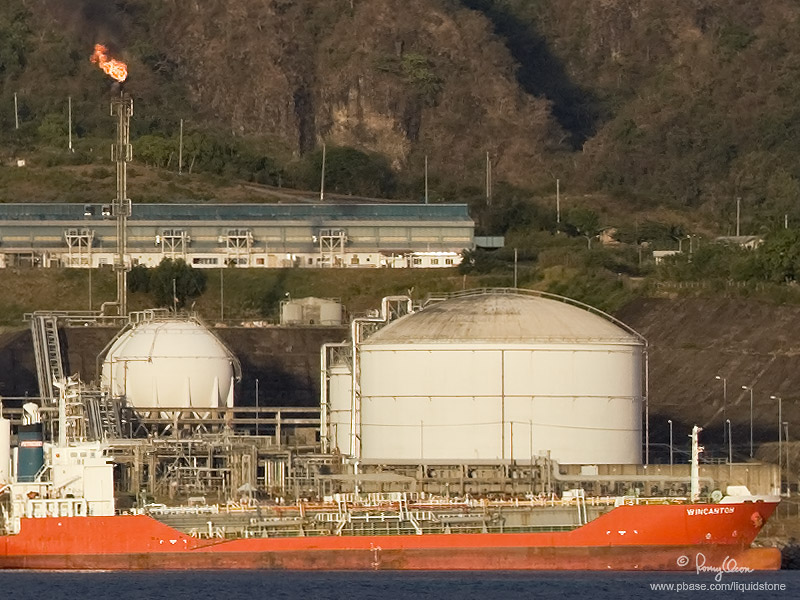
Trying the 100-400 IS on a full frame sensor
Scaly-Breasted Munia (Lonchura punctulata), 5D2 + 100-400 L IS, 400 mm, f/5.6, ISO 320, 1/250 sec, hand held, near full frame resized to 1200x800

Processed 100% crop
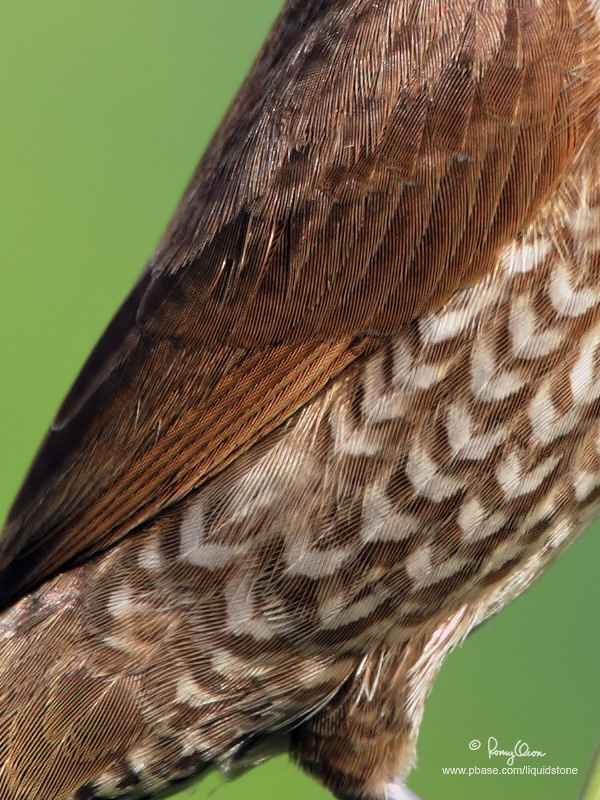
Scaly-Breasted Munia (Lonchura punctulata), 5D2 + 100-400 L IS, 400 mm, f/5.6, ISO 320, 1/250 sec, hand held, 6 MP crop processed and resized to 1200x800

Resized full frame and processed 100% crop

Torturing the 100-400 IS with the 7D's tiny pixels
7D + 100-400 IS, 400 mm, f/5.6, ISO 200, 1/1000 sec, spot AI servo with off-center point, IS off, hand held, resized full frame

Processed 100% crop of the above (oversharpened slightly in ACR to optimize detail)

Some captures of Barn Swallow (Hirundo rustica) in the air:
Shooting info - Paranaque City, Philippines, March 15, 2010, 7D + 100-400 IS, 400 mm, 1/1600 mm, f/5.6, ISO 400, hand held, major crop

Shooting info - Paranaque City, Philippines, March 15, 2010, 7D + 100-400 IS, 390 mm (the zoom unintentionally crept back), 1/1600 mm, f/5.6, ISO 400, hand held, major crop

Shooting info - Paranaque City, Philippines, March 15, 2010, 7D + 100-400 IS, 400 mm, 1/1600 mm, f/5.6, ISO 400, hand held, major crop

Warmest regards from our islands ,
,
Romy Ocon
Updated March 16, 2010
Canon 400 5.6L (rightmost) and Canon 100-400 L IS (second from the right), in the company of their bigger brothers (Sigmonster and 500 f4 L IS)

The 400 5.6L is cheaper, lighter, faster focusing and has a sturdier lens hood. But it has no IS, minimum focus distance is a far 11.5 feet, and being a prime, one has to zoom with the feet.
The 100-400 L IS has stabilization, framing flexibility and closer minimum focus distance (6 feet). But it has a flimsy hood design, not quite as long as the prime at 400 mm, a bit slower AF, higher price, and many of the earlier copies are not so sharp at full zoom wide open.
SUBIC BAY (January 2005): I was shooting a Philippine Woodpecker at Triboa Bay Mangrove Park with the hand held 300D + 100-400 L IS + DG Super + Better Beamer, while my 20D + 400 5.6L hangs ready in case some flying raptors come into view.

My first 100-400 L IS (mfd year 2002) was soft at 400 mm wide open, and became decent only when stopped down to about f/7.1-f/8. Then I stumbled upon an excellent copy of the zoom (mfd year 2005) over a year ago. I promptly sold my first copy. This second copy of the zoom matches the sharpness of my 400 5.6L at full zoom wide open (see following lens test).
Shoot-out: Canon 100-400 L IS vs Canon 400 5.6L (dial-up warning - 1.1 MB file)
www.pbase.com/liquidstone/image/86416630/original
The 400 5.6L, with its light weight and faster AF, is a flight specialist - Whiskered Tern, 1DM2 + 400 5.6L, 1/1600 sec, f/8, ISO 250, hand held:

On the other hand, the 100-400 with its IS is easier to hand hold - 1DM2 + 100-400 IS + Sigma 1.4x TC, 560 mm, f/8 (wide open), 1/320 sec, ISO 400, hand held:

So, going back to the question of which lens I recommend after taking thousands of bird photos with both..... I'd lean towards the 100-400 L IS but on the condition that it has to be tested first before one commits buying to make sure it's a good copy.
If one can get a zoom copy which is as sharp as the prime at 400 mm wide open, like I did, the choice is quite very easy. Since getting my prime-sharp 100-400, my 400 5.6L was relegated to back-up duty and has rarely left my camera bag, even at BIFs - Whiskered Tern, 40D + 100-400 IS, 400 mm, f/5.6, 1/1600 sec, ISO 400, hand held:

And a major crop of a dark flier in fading sunlight - Barn Swallow, 1DM2 + 100-400 L IS, 400 mm, f/5.6, ISO 500, 1/800 sec, hand held:

A Little Egret in flight over Candaba wetlands - 1DM2 + 100-400 L IS, 400 mm, f/7.1, ISO 400, 1/1600 sec, hand held:

A quick test of the bokeh of each lens:


A Purple Swamphen (Porphyrio porphyrio) captured at Candaba wetlands with the hand held 1DM2 + 100-400 IS, 400 mm, f/5.6, ISO 320, 1/400 sec, manual exposure, resized full frame:

Processed 100% crop of the above photo:

Another processed 100% crop, same settings as the above photo (Note - I've printed the full frame of this photo to 20"x30" for a museum exhibit and it's still so sharp that I believe it can still be upressed to 24"x36" easily):

Trying the 100-400 IS at the moon with a 2x TC:


Getting greedy with a 2.8x TC on the 100-400 IS!


And getting most greedy with a 4x TC!

With its framing flexibility, the 100-400 works decently at landscapes too, and IS helps a lot in hand holding.
1DM2 + 100-400, 120 mm, f/10, ISO 250, 1/200 sec, manual exposure, hand held from a moving ship, 98.6% of full frame (due to horizon correction), resized to 1200x800:

100% crop from the center:

100% crop from the right edge:

Trying the 100-400 IS on a full frame sensor
Scaly-Breasted Munia (Lonchura punctulata), 5D2 + 100-400 L IS, 400 mm, f/5.6, ISO 320, 1/250 sec, hand held, near full frame resized to 1200x800

Processed 100% crop

Scaly-Breasted Munia (Lonchura punctulata), 5D2 + 100-400 L IS, 400 mm, f/5.6, ISO 320, 1/250 sec, hand held, 6 MP crop processed and resized to 1200x800

Resized full frame and processed 100% crop

Torturing the 100-400 IS with the 7D's tiny pixels
7D + 100-400 IS, 400 mm, f/5.6, ISO 200, 1/1000 sec, spot AI servo with off-center point, IS off, hand held, resized full frame

Processed 100% crop of the above (oversharpened slightly in ACR to optimize detail)

Some captures of Barn Swallow (Hirundo rustica) in the air:
Shooting info - Paranaque City, Philippines, March 15, 2010, 7D + 100-400 IS, 400 mm, 1/1600 mm, f/5.6, ISO 400, hand held, major crop

Shooting info - Paranaque City, Philippines, March 15, 2010, 7D + 100-400 IS, 390 mm (the zoom unintentionally crept back), 1/1600 mm, f/5.6, ISO 400, hand held, major crop

Shooting info - Paranaque City, Philippines, March 15, 2010, 7D + 100-400 IS, 400 mm, 1/1600 mm, f/5.6, ISO 400, hand held, major crop

Warmest regards from our islands
 ,
,Romy Ocon
Updated March 16, 2010





